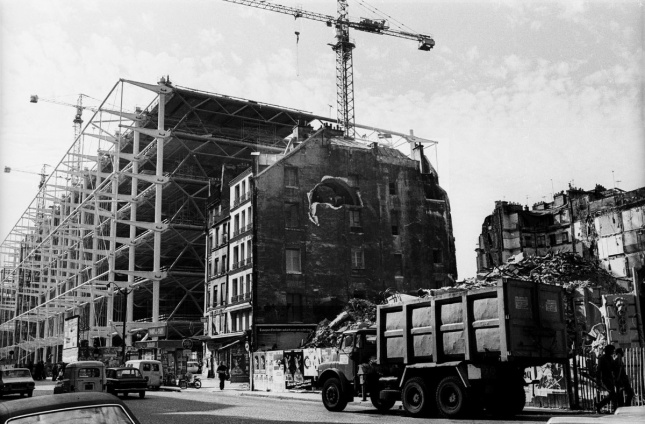As Christopher Hawthorne moves on from the Los Angeles Times and as new forms of criticism proliferate, we asked the architecture community what the role of the critic is today, and what it might be missing.
What do you see as the role of the critic in architecture today? Why is it important?
What aspects of architecture are not being addressed today by critics? What are the problems with criticism today?
Here are the responses we received from those who drew attention to the role that technology has played in changing the discourse, from across the country and abroad. This article was originally published in our May print issue and was preceded by a selection of answers from architecture critics themselves. Stay tuned for further perspectives from practitioners, emerging architects, and scholars.
Sam Jacob
Principal of Sam Jacob Studio, professor of architecture at the University of Illinois at Chicago, and columnist for ArtReview and Dezeen. Previously he was a founding director of FAT Architecture.
“I think we’ve seen the decline of the traditional kind of critic (partly because there are simply fewer professional critic jobs) and the rise of a different kind of critic. This new criticism seems to spill over from blogs, from zines, even from Twitter, and inhabits or attaches itself to bits of the internet rather than a particular title. It’s criticism you follow in sporadic streams, link by link, rather than a joined-up totality. This fractured landscape allows a more partisan, more pointed form of criticism. And more voices, each skewed to a particular kind of idea around the significance of architecture. That’s meant, I think, two things: First more direct discussion of the politics of architecture and second, more discussion around the cultural significance of architecture. Both are important, both have given us new ways to understand architecture’s role in society.
It’s really a more traditional idea of criticism that has declined. Forms of criticism like the building study, for example, where the critic acts as an arbiter of quality, and as a guide to the way we can understand architecture in historical and disciplinary senses. And this is a shame. It’s a form of criticism that is more expensive to produce (you have to travel) and is less opinion-led, less thinkpiece-y, and probably less clickbait-y, too. The danger, as this kind of criticism declines, is that it just becomes all opinion, written from the desk rather than the field. In this way it mirrors the transformation that’s occurred throughout traditional media. And while the greater diversity of voices is fantastic, perhaps we are losing a way of interrogating, understanding, and communicating ideas about architecture itself, where architecture becomes simply a cipher for other ideas, instead of considering its significance as architecture itself.”
Charles Holland
Architect, writer, and teacher. He is the principal of Charles Holland Architects and a professor of architecture at the University of Brighton.
“I think the role of the opinion-forming, influential critic is more or less dead. Everyone is a critic now. The rise of social media and sites like Dezeen where the architecture is presented without editorial comment and the critique occurs ‘below the line’ is a clear manifestation of this. The existing idea that critics define and drive artistic movements in the manner of Reyner Banham and Brutalism or Charles Jencks and postmodernism was probably overstated to start with but seems highly unlikely today. That’s not to say the there aren’t good critics around (critic Rowan Moore, for example, is great), but I think the landscape has shifted. The role of the critic today is messier and more ambiguous, blurring the roles between architect, critic, and curator with some people acting happily as all three. My social media feed is full of architectural criticism, only a small amount of which you could ascribe to a critic in the traditional sense.
The ‘problem’—if indeed it is one—is that it is harder to establish a critical body of thought or momentum for any one particular position. This is a product of pluralism and a genuflection away from forms of authority, at least overtly. Criticism traditionally served the role of establishing value, of sifting through things to define what’s good, what’s bad and establish the ‘canon.’ That sifting doesn’t really take place with any clear rationale or legitimacy anymore, which is threatening and liberating in equal measure. Architectural and artistic movements are established through a kind of accumulation of works which address similar things and by events like the biennials, which aren’t criticism in the traditional manner, but which establish what is (supposedly) relevant or pressing at any one time.”

David Ruy
Architect, theorist, director of Ruy Klein, and Postgraduate Programs Chair at SCI-Arc
“Criticism falls prey to the general degradation of institutional authority in producing and disseminating information in the contemporary situation. This is the problem posed by Google, Facebook, Twitter, Instagram, Reddit, and other platforms of our telematic infrastructure. Any person or group with an account on these platforms can produce and disseminate information. Any person or group with an account can produce criticism.
In 1976, Simon Nora and Alain Minc were asked by France’s president, Valéry Giscard D’Estaing, to issue a report on the dangers and possibilities of a computerized society. Astonishingly, given what’s happening in the world today, they predicted a coming society where anyone with access to the telematic infrastructure could manufacture and disseminate information, leading to a loss of trust in the veracity of information and to an erosion of the cultural coherence in the society. They warned that such a society might be ungovernable. This was nearly two decades before the first internet browser became available. It is sobering then to consider their recommendation for addressing this danger. They proposed a socialization of information. What this might mean in the twenty-first century remains unclear.
A lot of good architectural criticism is still being written today, but it gets lost in the sea of information that is available. The dialectic of fact versus fiction has melted into a flat ontology of mere data. The cynic today would ask in boredom if it even matters that the news is fake. But this is true for all criticism today. There are only two options I see in the face of the contemporary situation. We would either have to rebuild the authority of old institutions (which seems impossible), or we would have to understand that communication and its politics will have to be hypothesized in a new way outside of the framework of criticism (because after all, how can you have criticism without authority?). As sad as I am about this, when anyone can disseminate information, when anyone can ‘like’ or ‘troll’ an idea, when anyone can invent ‘news,’ when the theater of criticism appears more important than the criticism itself (Fox News and MSNBC, for example), what role can any critic play outside of the limited audiences that consumes critique primarily for reinforcing existing opinions? It may be tempting to conceptualize some ‘post-criticism’ society, but as Nora and Minc warned, such a society might be ungovernable.
Nonetheless, I continue to think about Nora and Minc’s proposal of socializing information. I consider it to be an important but enigmatic problem. If, miraculously, something can be figured out and implemented one day, I think criticism would have newfound authority. But I think it is premature to dream about the possible positive effects of such a rebirth and the roles the critic might play until we address how to construct such a structure in society.
Strangely, I think every constituency thinks their opinions are not being properly addressed. I have my own complaints, but I’m pretty sure everyone has a complaint and feels underrepresented. This is true despite the irony that, no matter how marginal or preposterous, any opinion and orientation to society can be searched for online, and criticism can be found in support of it.
With that said, speaking for my own values and my own small constituency, I am puzzled and dismayed by how the left end of the political spectrum seems to be abandoning architectural speculation and formal experimentation. I got into architecture out of a dissatisfaction with the world as given. How can the world be more progressive if everything remains the same or goes backward towards the historically familiar? I understand that in recent times formal extravagance was appropriated as a risk management device by large investors. But how can progressives abandon the project of imagining other possible realities? Isn’t this one of the things architecture does so well? Is demystifying power the only thing left to do? Instead of contributing to the ever-growing disenchantment in the world, can architectural criticism re-enchant some of these abandoned spaces?”

Michael Young
Partner at Young & Ayata and assistant professor at The Cooper Union.
“One of the issues facing contemporary architectural criticism that has yet to be fully developed is how to deal with the dissemination and consumption of architectural images on social media. The primary responses thus far have been to treat it as either a wasteland or a wilderness. The wasteland response sees the image proliferation as out of control and debased, a condition to be excluded from disciplinary criticism. The wilderness response views the image accumulation as wild yet vibrant, a condition to be cultivated and curated. The problem lies in that architecture’s typical disciplinary approaches of criticality that aim to reveal underlying hierarchies, trends, and motivations cannot keep pace nor dent this image acceleration. Social media flattens access, evaluation, and debate. This is both numbing and exciting. It is where the wasteland meets the wilderness. And this requires a different paradigm for architectural criticism.”
Francois Roche
Principal, New-Territories
Architecture critics died… nobody told you !
For refreshing …If you talk about text in Chicago style, where references and self-references are developed in a strategy of the narcissus discourse and onanism, with a pinch of left side to caress in a kind of arrogance the moralistic sensation to belong to the elite, in a predictable social class discrimination, drinking millesimal red wine with good consciousness, to engage mercy and charity on the back of the misery of the worlds!!… making kressel music with entertaining name dropping in a flattering play, to get the lift back /// but you could also refuge in a strategy to build a fortress of knowledge and expertise, as a gold bubble ghetto, for dogmatic control of what which should not be told… …Or… to hear the pseudo philosophers “dedicated” to architecture, in a vulgarization of the thought… clever monkey parrots…in a parade of brainy speeches bubbles…AT the condition to never request ion the “voice of the master”…
Ryan Scavnicky
Visiting teaching fellow at the School of Architecture at Taliesin, administrator of the Facebook page “Dank Lloyd Wright” and on Instagram as @sssscavvvv.
“I think the strength of memes isn’t just about its experimental form. It’s the same principle I apply to architecture but applied to criticism. With architecture, I’m always skeptical about what it actually has the power to do. So with criticism, we probably shouldn’t be focused on changing individual architects (have you met these people?) or critiquing specific buildings, but changing architecture culture in general. Memes focus on changing the student’s perception, loosening the bolts a bit and moving architecture culture away from toxic bravado and into a new space while regaining our singular command over the built world with a more public audience.
I do this through producing and writing films as a YouTube comic-critic team with Jeffrey Kipnis via the SCI-Arc Channel and by running a meme account on Instagram. Internet memes are the strongest emerging form of cultural criticism today, thriving in the form of quick and digestible images pregnant with assertive positions. Critics must develop fresh audiences by using strange and experimental critical forms and reflecting those findings back onto the architecture discipline.”
Ellie Abrons
Principal of T+E+A+M and an assistant professor at the University of Michigan Taubman College of Architecture and Urban Planning.
“In the past, critics (and theorists, I’d add) drove architectural discourse and were vital participants in its culture. They had the ability to read work very closely and to interpret or understand it with focused attention and intellectual prowess and agility. Critics played a crucial role in contextualizing work, in situating it culturally and historically or finding affinities and overlaps with other fields. These days, there’s a dearth of criticism—you don’t see the same quantity and quality of writing that was coming out fifteen or twenty years ago. I see more and more architects writing about their own or their peers’ work in an attempt to play that role. But we’re not really cut out for it, so we end up with thought pieces or musings more than proper pieces of criticism or theory. I’m not prepared to say that it’s a bad thing – it’s just a new model. Contemporary intellectual, professional, and cultural life doesn’t allow the kind of patient and careful interpretation of work that we saw in the past. Our modes of attention have changed due to ever-expanding digital culture—images scroll by, while texts are limited to a caption or a few hundred words. Architecture in general (critics, but also architects, historians, and others) need to better understand how to participate in a world where ubiquitous digitality has altered the material, conceptual, and experiential context of our work.











